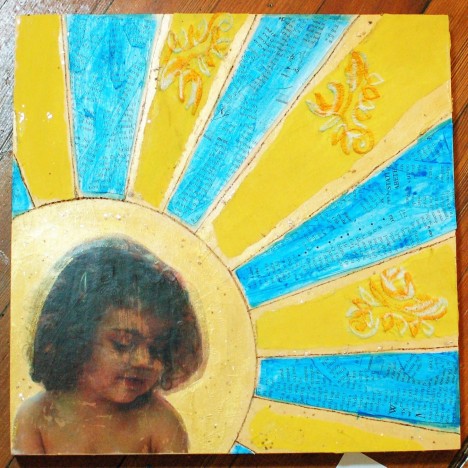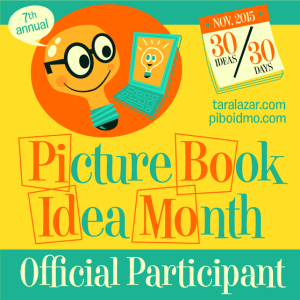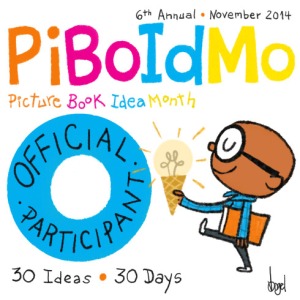In my perusal of the internet in search of non-sexist picture books, I have come across several people hailing Ladybug Girl by David Soman and Jacky Davis as a feminist celebration of children’s imagination. Being drawn to children’s books that break down gender and other stereotypes, I had to check out the series for myself. Overall I would say that these are some of my favorite picture books, but that they do fall into some of the more typical traps of gender stereotyping.

Cover of Ladybug Girl
The series justifiably garners a lot of praise for depicting a young girl using her imagination to be independent and capable. Whenever Lulu finds faces a challenge, whether that is building a fort in Ladybug Girl, finding her trusty dog Bingo in Ladybug Girl and Bingo, facing down an army of giants in Ladybug Girl and the Bug Squad, or finding ways to compromise in Ladybug Girl and Bumblebee Boy she reminds herself that she is Ladybug Girl and Ladybug girl can do anything! Whether the challenges are part of her imaginary play, like the army of giants, or real-life conflicts with friends, she is able find the courage and strength to find her own solutions. This is a powerful antidote to tropes that cast girls and women as damsels in distress.
However, I think the series is more accurately a celebration of imagination rather than feminist offering for young children. While the companion board book Ladybug Girl Dresses Up shows Lulu in a variety of costumes, including typically masculine characters like Sherlock Holmes, the character that gives the series its name is the tutu-clad Ladybug Girl. As a woman who has always insisted that I can climb trees and go hiking in skirts just as easily as pants, I appreciate the fact that the tutu doesn’t slow her down. Still, she may be deviating from the princess norm, but she is hardly escaping the expectation that girls find their power in ruffles and bows.

Cover of Ladybug Girl and Bumblebee Boy
The books become more enmeshed in problematic social norms when we exit the world and see her interacting with other children and her family. Ladybug Girl and Bumblebee Boy introduces Lulu’s friend Sam from music class. The two children struggle to find common interest on the playground–Sam wants to play diggers, Lulu doesn’t want to get sand in her boots, Lulu wants to play on the teeter-totter, but Sam isn’t interested. Realizing that she never has trouble finding fun things to do when she is Ladybug Girl, Lulu invites Sam to join her in imaginative play. He agrees, and as Bumblebee Boy works with Ladybug Girl to vanquish a giant snake, save Bingo from a monster, and otherwise defend the playground from danger.
While I appreciate using imagination to find common ground, I couldn’t help but notice that the imaginative games change when Lulu has a male playmate. Left to her own devices, Lulu rides giant turtles, builds forts, and hunts for treasure. When Sam joins the game, it becomes an “us vs. them” world of superheroes in conflict with villains. On the way to the playground, Ladybug uses her strength to help an elderly neighbor carry groceries; Bumblebee Boy uses his stinger (a stick) to battle a monster (the tire swing). From Lulu’s concern with getting dirty in the sandbox to her grudging admission that “being a princess wouldn’t be so bad,” the play preferences of the two children reflect gendered stereotypes about how girls and boys play. I find the minor character of Dragonfly Girl–who wears pants and is excited to be able to breathe fire–to be more compelling, but she does not get very much attention in the series.

Cover of Ladybug Girl at the Beach
Unfortunately, gender stereotypes extend beyond the children and their play styles. In Ladybug Girl at the Beach, we see Lulu’s father loaded up like a pack-horse carrying all the umbrellas, bags, and blankets necessary for the family outing to the beach, while Lulu’s mother walks with the children. While Lulu’s father is present in many of the books, he has few lines, making him more of a background presence in Lulu’s life than an active figure. This reflects common beliefs about the different roles of mothers and fathers. Lulu’s mother, on the other hand, has the time, energy, and money to prepare art projects and cupcakes for all of Lulu’s friends in Ladybug Girl and the Bug Squad.
Lulu lives in a very specific world–one where everyone is white (except for some background faces at the playground), where pre-school children enroll in music classes, where people live in large houses with giant libraries on acres of land (and yet can walk to a playground). While such settings are not unrealistic–there are in fact plenty of upper class families out there who take camping trips together, and trips to the beach, and have entire fields of sunflowers in their yard–I would like to see Ladybug overcoming some of the challenges that happen when children encounter kids from backgrounds different from their own.
Despite all of this deconstruction, I want to re-iterate that I really enjoy this series. I have read all of them to my son, and get excited when I find a new one at the library. The stories deal with real problems children face without being at all didactic or preachy, and the art is lovely. It would be a five-star series if it just worked a little harder at avoiding stereotypes and including more diversity.







 (Welcome Home Anna Hibiscus!).
(Welcome Home Anna Hibiscus!).










